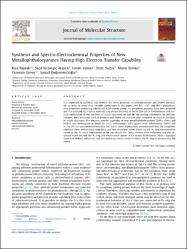Synthesis and Spectro-Electrochemical Properties of New Metallophthalocyanines Having High Electron Transfer Capability

View/
Date
2021Author
Bayrak, RızaKırlangıç Ataşen, Seçil
Yılmaz, İsmail
Yalçın, İzzet
Erman, Murat
Ünver, Yasemin
Değirmencioğlu, İsmail
Metadata
Show full item recordAbstract
It is important to synthesis and examine the redox properties of phthalocyanines and related macrocycles in order to reveal their possible applications. In this paper, new Zn2+, Co2+ and Mn2+ phthalocyanine complexes containing substituted 1,2,4-triazole groups on peripheral positions have been prepared
and characterized by classical methods and electrochemistry in detail. The use of triethylamine and acetone combination in the synthesis of nitrile structures 3a and 3b, the starting compounds for phthalocyanines, both increased yield of products and shortened reaction time compared to classical synthesis
of nitrile structures. The electron transfer capability of new metallophthalocyanines (ZnPcs, CoPcs and
MnPcs) was investigated in detail via cyclic voltammetry (CV), square wave voltammetry (SWV) and
in situ UV–vis spectroelectrochemistry. For ZnPcs, these experiments demonstrated that the complexes
exhibited three well-defined reductions and two oxidations waves based on the Pc ring electroinactive
nature of the Zn metal coordinated to the macrocycle. For CoPcs showed three reductions and one oxidation based on both the Pc ring and electroactive nature of Co center. Furthermore, MnPcs displayed
three well-defined reductions and two oxidations waves based on either the Pc ring or electroactive Mn
center.
Volume
1231Collections
The following license files are associated with this item:

















